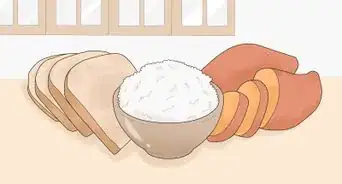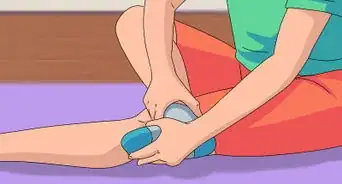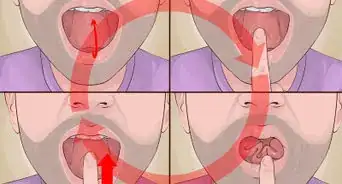This article was co-authored by wikiHow Staff. Our trained team of editors and researchers validate articles for accuracy and comprehensiveness. wikiHow's Content Management Team carefully monitors the work from our editorial staff to ensure that each article is backed by trusted research and meets our high quality standards.
The wikiHow Video Team also followed the article's instructions and verified that they work.
This article has been viewed 294,310 times.
Learn more...
The wink can be a way of communicating many different ideas or feelings without the use of words. It is thought to come from an ancient Norse myth about the god Odin, who traded one of his eyes for the opportunity to drink from a well that would give him great knowledge. Learning to wink is simple, but knowing what a wink means or when to use it can be a bit more complicated.
Steps
Learning to Wink
-
1Make eye contact. When you wink at someone, you only communicate something if they see you winking. So, before you do anything else, make eye contact with the person you plan to wink at.
-
2Choose the eye that feels most comfortable. Some people find it easier to wink with one eye than the other, while others can wink equally well with both.
- Try each eye separately when no one is around in order determine which is easier for you.[1]
- You may find that trying to wink with one eye will cause your face to "scrunch" more than the other. Or it may be that when winking with one of your eyes, you find it harder to control the other, making your wink look more like a blink.
Advertisement -
3Lower your eyelid. Lower the eyelid of the chosen eye while keeping the other eye open. When you are first starting out, you may have to concentrate pretty hard to make this work.
-
4Slightly raise your cheek muscle. Especially when you are first learning to wink, you may need to raise your cheek slightly to achieve full closure of the eye.
- With practice over time, you should find you have to do this less and less.
-
5Don't squint. Try hard not to squint with the eye you are keeping open. The effort of keeping this eye open sometimes results in squinting for the beginning winker.[2]
- When you first start out, this squinting will be hard to control. Again, with practice, you'll find you are doing this less and less.
-
6Open your eye. Once you've fully closed the winking eye, open it back up again. That's it!
-
7Practice in a mirror. When you are first learning to wink, you'll probably find it helpful to practice alone in a mirror. Make eye contact with yourself and practice your winks.[3]
- With enough practice, this will start to look and feel natural.
-
8Practice on a friend. When you think you've got it down, ask a friend to have a look at your winking. He or she can tell you whether it looks good or if you are still squinting or otherwise making it look like an effort.[4]
Knowing When to Wink
-
1Say hello with a wink. Once you know how to wink, the next step is knowing when to do it. One common use of the wink is just to greet someone or say hello.
- For example, imagine you are at a party and are deep in a conversation with some friends. Another friend comes into the room, but you don't want to break up the flow of the conversation you are already in. A quick wink can be gesture of greeting that won't interrupt the conversation.
-
2Wink to indicate shared knowledge. Like Odin's missing eye, the wink can be a sign that you know something. It often has a conspiratorial meaning, suggesting that you and the person you are winking at understand something that others do not.[5]
- Winks can be used, for example, as a way to indicate humor between you and another person. A wink can mean: "I know you get this joke, even though other people may not." It can also be a way to show someone you are joking when you say something ironically. For example, if you have a friend who knows a great deal about history, you might say: "I have a really tough history paper to write this week. Too bad I don't know anyone who could help me out with that!" and then wink.
- This kind of wink can also be used to mean that some plan you made should be put into motion. If you and some buddies are going to ambush a friend with water balloons, for example, a well placed wink could mean "Go get those water balloons now!"
-
3Reassure someone with a wink. A wink can also be used to reassure someone who seems to be experiencing difficulty in some situation. It works almost like a pat on the back.
- For example, imagine a friend of yours is giving a public speech, and you know he or she is really nervous. If you are sitting in the audience and your friend makes eye contact with you, a wink can send the message: "You've got this pal."
-
4
-
5Know when not to wink. There are some cases when winking can cause socially awkward situations or even get you in trouble. Be careful, in particular, about winking at the opposite sex.
- Winking at someone of the opposite sex is often assumed to be an act of flirting. If this isn't your intention, think twice about winking. You may be misunderstood, especially if the person you are winking at doesn't know you well.
- A misplaced wink can make people angry, especially if it might convey that you aren't taking them seriously or that you are being inappropriately sexual. Especially if you are in a position of authority, be careful about the situations you wink in.[8]
Winking Online
-
1Use the wink emoji. In this modern world of cell phones and computers, using your eyes is not the only way to wink. You can communicate a wink via text message or a social networking site using a winking emoji.[9]
- There are different types of winking emojis, depending on what type of phone you have, what social networking site you are using, etc.
- An emoji wink is usually used to communicate that something is a joke, or to flirt.
-
2Wink with an emoticon. Before emojis were created, people would often use punctuation marks to create a winking face. Some people still prefer this style, called an "emoticon," or use it because they have an older phone, or are using an email system that doesn't support emojis. You can communicate a wink in any of these ways:[10]
- ;)
- ;-)
- (-!
- ~_^
-
3Use *wink*. A less common way to indicate a wink in text or email that some people use is simply to place the word "wink" between two asterisks. This works in the same way as an emoticon or emoji to convey humor or flirtation.
Community Q&A
-
QuestionWhat causes my other eye to twitch when I try to wink?
 Community AnswerBecause you are used to closing both of your eyes instead of just one; it's a sympathetic reaction from the other eyelid. Keep practicing, your body will get used to it.
Community AnswerBecause you are used to closing both of your eyes instead of just one; it's a sympathetic reaction from the other eyelid. Keep practicing, your body will get used to it. -
QuestionIs it true that some people aren't capable of winking?
 Community AnswerNo, although it may be difficult for some people to wink.
Community AnswerNo, although it may be difficult for some people to wink. -
QuestionHow do I stop my other eye from squinting when I wink?
 Community AnswerKeep practicing. It's pretty much muscle memory once you get used to it. It may be hard at first.
Community AnswerKeep practicing. It's pretty much muscle memory once you get used to it. It may be hard at first.
Warnings
- Winking can look like a nervous twitch if you do it too fast or too often.⧼thumbs_response⧽
References
- ↑ http://slism.com/girlstalk/how-to-wink.html
- ↑ http://slism.com/girlstalk/how-to-wink.html
- ↑ http://slism.com/girlstalk/how-to-wink.html
- ↑ http://slism.com/girlstalk/how-to-wink.html
- ↑ http://changingminds.org/techniques/body/parts_body_language/eyes_body_language.htm
- ↑ http://changingminds.org/techniques/body/parts_body_language/eyes_body_language.htm
- ↑ http://slism.com/girlstalk/how-to-wink.html
- ↑ http://www.psy.unsw.edu.au/news-events/media/2014/05/think-you-wink
- ↑ http://emojipedia.org/winking-face/
About This Article
To wink at someone, make eye contact with them, then lower one of your eyelids. You can also raise your cheek muscle while lowering your eyelid to close your eye completely. While you wink, try to avoid squinting with your open eye. Then, open your winking eye back up to finish. Before you try winking at someone, practice your wink in the mirror until it looks relatively natural. To learn when it's appropriate to wink at someone and when you shouldn't, read on!






























































